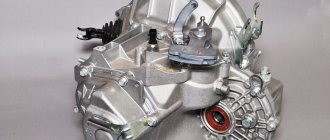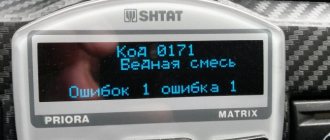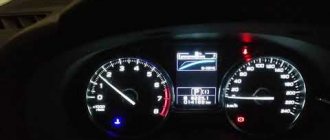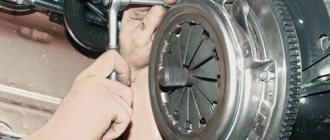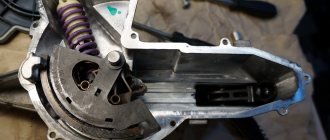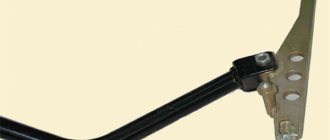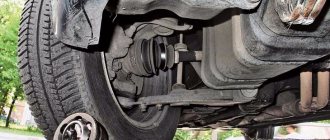How does a crunching sound manifest in a gearbox?
There is an unspoken rule among drivers - to start driving a car with the radio turned off. This is necessary to immediately check whether there are any extraneous knocks, noises or other sounds that may indicate a malfunction of a particular unit. The following sounds will indicate problems with the gearbox:
- A crunching sound when engaging a gear, and often it can only appear in one of the gears, for example, in reverse;
- Crackling noise when returning the gearshift lever to neutral.
If you notice one or both of the symptoms in the operation of your box, you should determine and eliminate the cause as soon as possible.
Grinding and vibrations
From the point of view of physics, the gearbox in a car is a step-by-step lever system that transfers energy from the engine to the wheels. Today, there are a number of types of gearboxes - mechanical, hydromechanical (automatic), robotic, CVT. Each type of transmission works differently, however, there are common signs of transmission failure.
“You should be concerned and take decisive action as soon as possible if you hear strange noises when changing gear or notice oil leaking from the gearbox. The machine may also experience increased vibrations. A normally functioning transmission does not show any of these signs,” says Vyacheslav Kondratiev .
To find out the cause of the malfunction, experts advise first checking the level and color of the oil in the transmission. Low level and dirty oil in the box can damage it.
Experts say that for proper operation of the transmission, it is necessary to add oil strictly according to the level. If it is not enough, then overheating is likely - the worst enemy of the gearbox.
Why does the gearbox crunch?
There are many reasons why a crunching noise occurs when the gearbox operates. Eliminating some of them does not require much intervention in the mechanism, while others require a near-overhaul of the box. Most often, the gearbox crunches when changing gears for the following reasons:
Synchronizer malfunction. The problem may lie either in the failure of the element or in the insufficient amount of lubricant in the part. If the synchronizer has “crumbled” due to age, the lubricating components with the resulting “garbage” risk causing serious damage to the entire unit, so the situation needs to be corrected as soon as possible;
Unsuitable oil
The transmission can be damaged if the wrong oil is used.
“The requirements for a modern gearbox oil are: good fluidity over the operating temperature range, reliable wear protection, excellent synchronization, high oxidation and shear stability, low tendency to foam, good seal compatibility, high efficiency,” says Vyacheslav Mikhailovich.
Different types of gearboxes require special gear oils recommended by the manufacturer. If the oil is selected incorrectly, slippage and vibration begin, fuel consumption increases, wear increases, and the oil can burn.
How to avoid crunching noises in the gearbox
Most often, gearbox malfunction occurs due to improper care of it. Manual transmissions require regular lubrication, which drivers often forget about, assuming that such procedures are only required for automatic transmissions. If the lubricant loses its properties, this can lead to serious consequences, including failure of individual components and mechanisms.
Experts recommend replacing the lubricant in a manual transmission every 45-50 thousand kilometers. If the vehicle is driven under particularly severe conditions, change the oil more often.
Please note: It is especially important to promptly change the lubricant on a front-wheel drive vehicle.
By lubricating gearbox and suspension elements in a timely manner, you can avoid expensive repairs and early failure.
Hello everyone. The second gear shifts with a crunch. I know it's synchronous. Tell me, how much does a synchronous replacement cost and how long can you drive?
Bolts from casting will be used for dies
by Adminrive · Published 10/24/2015
It seems to be a little cold
by Adminrive · Published 05/12/2016
TOP 6 common mistakes with manual transmission
Shifting gears without clutch
It sounds very strange, given the type of gearbox, but beginners and drivers who have been driving an automatic for a long time often forget to depress the clutch when shifting.
The result is a strong crunch, and a quick realization of the mistake made. At these moments, the box experiences unforeseen loads due to the fact that at the moment of switching the box is not disconnected from the engine, and therefore is under load. Sometimes such pranks end in licking or, even worse, breaking off fragments of gear teeth. As a result, the mechanism “grinds” itself and the manual transmission is simply inevitable.
Clutch depressed
Many car enthusiasts systematically hold the clutch pedal depressed for a long time. For example, when they are standing at traffic lights or just stopped.
This, at first glance, harmless action leads to increased wear of the clutch disc, but what “suffers” the most is the release bearing, which is tirelessly forced to rotate under load. As a result, it quickly becomes unusable (it buzzes), as a result of which it will require immediate replacement, because there is a risk that it will “scatter” right on the move. By the way, to replace it you will have to remove the box, which is not a cheap pleasure.
Engaging reverse gear without coming to a complete stop
A classic of the genre, the driver tries to quickly turn around in the yard, in a hurry, first and then reverse gears. We hear an unpleasant grinding noise when we obviously try to engage the rear.
The reason is simple: the pilot is trying to engage reverse without making a full stop. This has an extremely negative effect on the teeth of the reverse gears, which slowly become unusable due to licking off on one side. If such an error becomes permanent, the reverse gear will engage worse and worse from time to time, until it completely fails.
Downshifting by two or more
Due to the fact that in a manual transmission the function of selecting gears is assigned to the driver, there is a high probability of engaging an inappropriate gear. In cases with downshifts, this is especially dangerous. After all, if the wheel speed turns out to be higher than the maximum possible in the gear selected by the driver (cutoff), when the clutch is released, extreme engine braking will occur. As a result, not only can the gearbox and clutch fail, but also the timing belt in the engine can jump over a couple of teeth (the chain is no exception, but less often), or even break completely (usually an expensive repair).
In addition, with such sharp engine braking, the drive wheels will slow down momentarily, incomparably with the speed of the car, which can cause the car to fall off the trajectory when turning, especially in winter.
If you drive a manual transmission, you should know which gear is which “maximum speed” and avoid “wrong” downshifts.
Hand on the lever
Many drivers, when moving, keep their hand on the gearshift lever, as if on an armrest.
On the one hand, it seems to be convenient, on the other hand, it loosens the mechanism and “kills” the forks that directly move the clutches in the gearbox. Those who want to save the box must understand that while driving the car oscillates chaotically and the driver does not consciously hold on to everything his hands are on. As a result, the load on the lever turns out to be not so small, and the box loses its original “tightness”
Released clutch
As you know, the clutch is an integral part of a manual transmission. It is involved in the process of shifting gears (discussed above) and “taking off” from a place. The most detrimental thing is slipping of the clutch disc at the moment of start. Because the entire assembly gets very hot and simply wears out due to friction. Some drivers do not know about this and use the clutch incorrectly, thereby significantly reducing its service life.
For example, when standing on an incline in a drag, they hold the car in place by not fully grasping the clutch (the clutch pedal is not fully released) or they drive onto a curb/obstacle not due to inertia (at low speeds), as needed. And due to the moment of clutch engagement. Alas, the clutch will not serve its intended life this way. And the work to replace it will cost a pretty penny, because you will have to pay not only for new spare parts, but also for dismantling the box.
Results
Everyone makes their own decision whether to pay attention to all of the above or not. On my own behalf, I will add that due to the design features, the mechanics themselves are very reliable, and the only thing that can quickly “ruin” them is incorrect actions by the driver. Follow your iron friend and he will never let you down.
Well done author! And skidding is also harmful. At any checkpoint.
Vip07007, 10. You will be acquitted.
Failures that cause crunching when changing gears
Crunching noise when shifting gears can be caused by several factors. The first and, admittedly, most popular is considered to be the breakdown of any unit, and the crunch in this case is only a symptom. Among the main breakdowns that cause such unpleasant sounds when switching gears are: 1. Failure of synchronizers . Synchronizers are responsible for smooth gear shifting. Over time, they wear out and cause a crunching sound when changing gears. Fixing the problem is quite easy - you need to replace these same synchronizers. However, only professionals should be trusted to carry out this type of repair. 2. The falling out of the clutch basket can also cause a crunching sound when changing gears. Replacing the clutch basket will eliminate this defect. 3. Clutch malfunction . Well, here words are superfluous - go for diagnostics, they will establish an accurate diagnosis. 4. Problems related to the gearbox shaft . The problem can be solved by replacing this unit.
Incorrect operation of the transmission, as the cause of a crunching sound when shifting gears
It is fair to say that often a crunching sound when shifting gears may indicate that the manual transmission is not being used properly. Therefore, it would not be amiss to provide some recommendations that will extend the service life of the manual transmission.
1. Timely replacement of transmission fluid in the box . Few people know, but in a manual transmission, just like in an automatic transmission, the oil should be changed periodically. A manual transmission does not require replacement as often as an automatic transmission, but still, after 70,000 kilometers, you should stop by a service station. If you ignore this recommendation, metal shavings and dirt will begin to accumulate in the oil, resulting in insufficient lubrication and crunching.
2. An insufficient amount of oil in the transmission can also cause a crunching sound when shifting gears. The solution is to add oil or, better yet, replace it .
As you can see, it’s quite easy to avoid crunching noise when changing gears!
Worn bearings
If a grinding noise appears in the gearbox when you shift into gear, but the sound disappears when you shift to neutral, this may indicate wear on the bearings. If these bearings are not replaced in time, the box may jam, which will lead to expensive repairs.
“It is recommended to check the transmission in accordance with the requirements of the car manufacturer. It needs systematic visual inspection. Care must be taken to ensure that oil does not leak. In addition, dirt should not get there, otherwise the gears will shift worse,” advises mechanical engineer Andrey Semenov .

